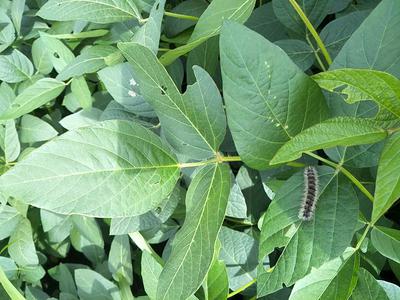Bihar Hairy Caterpillar
Spilarctia obliqua
Insect
In a Nutshell
- Drying up of infected leaves.
- Complete defoliation.
- Netted or webbed leaves.
- Brown moth with red abdomen and black spots.
- Larvae covered with yellowish to black hairs.
Can also be found in
Symptoms
Early infested leaves will become brownish-yellow and dry up. As the caterpillar proceeds, whole leaf tissues are eaten up. Under severe infestation, plants will be defoliated and only stems are left. Leaves appear netted or webbed and eventually are skeletonized.
Recommendations

Organic Control
Bihar hairy caterpillar population can generally be controlled by numerous natural enemies particularly in the larval stage of S. obliqua. Beneficial parasites are braconid parasitoids: Meteours spilosomae and Protapanteles obliquae, Glyptapanteles agamemnonis and Cotesia ruficrus in combination with Ichneumonid Agathis sp. lacewing, ladybird beetle, spider, red ant, dragonfly, praying mantis, ground beetle, and shield bugs

Chemical Control
Always consider an integrated approach with preventive measures together with biological treatments if available. Insecticides should be approached with caution because excessive usage of insecticides has caused many whitefly species to become resistant to them. To prevent this, ensure proper rotation between insecticides and use mixtures. Spray Lambda-cyhalothrin 10 EC @ 0.6 ml/lit of water when the caterpillars are young. Phenthoate 50% is also considered to help against S. obliqua.
What caused it?
The symptoms are mostly caused by the larvae of Spilarctia obliqua. The adult is characterized as a medium-sized brown moth with a red abdomen and black spots. Females lay their eggs (up to 1000/female) in a cluster on the underside of leaves. After hatching, the larva is covered with long yellowish to black hairs and pupates in leaf litter close to the plants. The early instar larva feeds on chlorophyll under the surface of leaves gregariously. In later stages, it eats leaves from the margin in a solitary manner. Generally, larvae prefer mature leaves, but under severe infestation also top shoots are affected. The Bihar hairy caterpillar attacks pulses, oilseeds, cereals and certain vegetables and jute in various countries, causing severe economic damage. The extent of yield loss varies with the infestation intensity and weather conditions as the species favors temperatures from 18 to 33°C for development.
Preventive Measures
- Plan a deep summer plowing to rid the soil of pupae.
- Avoid sowing before the monsoon.
- Use optimum seed rate, not more nor less.
- Adequate plant spacing should be provided.
- Apply well-rotted manures.
- Intercrop either with (early maturing) pigeon pea, some varieties of maize or sorghum.
- Monitor fields regularly for signs of the pest (egg masses, caterpillars and for any damages).
- Adopt an appropriate method of weeding either by herbicides or mechanically in the field and surrounding area.
- Collect infested plant parts and destroy them away from the field.
- Build perches and open space for birds that will feed on the larvae.
- Control the use of broad-range insecticides, as this can affect beneficial insects.
- Remove plant residues or volunteer plants after harvest.
- Follow with a crop rotation of non-host crops like rice or maize.



